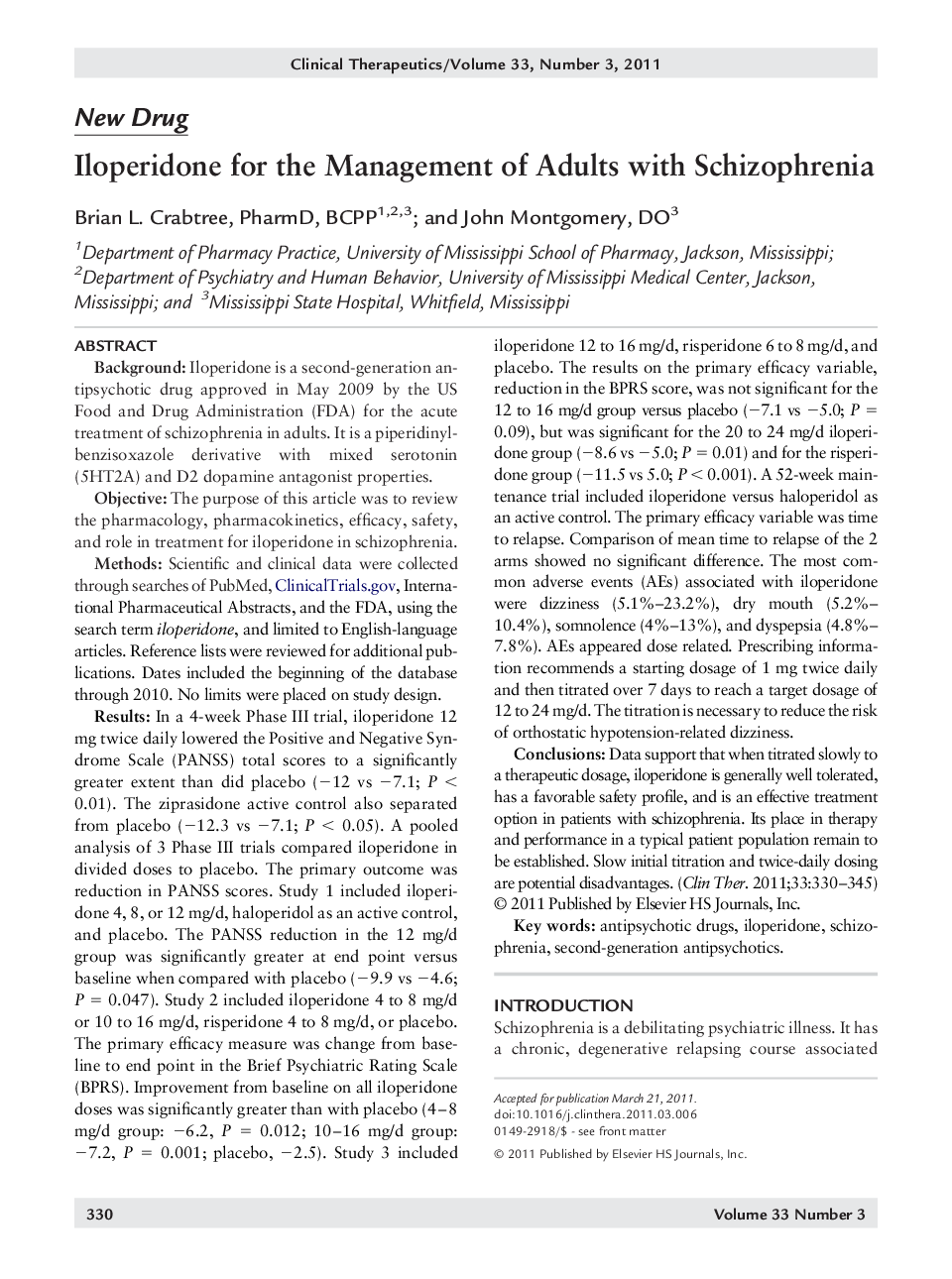| Article ID | Journal | Published Year | Pages | File Type |
|---|---|---|---|---|
| 2528433 | Clinical Therapeutics | 2011 | 16 Pages |
BackgroundIloperidone is a second-generation antipsychotic drug approved in May 2009 by the US Food and Drug Administration (FDA) for the acute treatment of schizophrenia in adults. It is a piperidinyl-benzisoxazole derivative with mixed serotonin (5HT2A) and D2 dopamine antagonist properties.ObjectiveThe purpose of this article was to review the pharmacology, pharmacokinetics, efficacy, safety, and role in treatment for iloperidone in schizophrenia.MethodsScientific and clinical data were collected through searches of PubMed, ClinicalTrials.gov, International Pharmaceutical Abstracts, and the FDA, using the search term iloperidone, and limited to English-language articles. Reference lists were reviewed for additional publications. Dates included the beginning of the database through 2010. No limits were placed on study design.ResultsIn a 4-week Phase III trial, iloperidone 12 mg twice daily lowered the Positive and Negative Syndrome Scale (PANSS) total scores to a significantly greater extent than did placebo (−12 vs −7.1; P < 0.01). The ziprasidone active control also separated from placebo (−12.3 vs −7.1; P < 0.05). A pooled analysis of 3 Phase III trials compared iloperidone in divided doses to placebo. The primary outcome was reduction in PANSS scores. Study 1 included iloperidone 4, 8, or 12 mg/d, haloperidol as an active control, and placebo. The PANSS reduction in the 12 mg/d group was significantly greater at end point versus baseline when compared with placebo (−9.9 vs −4.6; P = 0.047). Study 2 included iloperidone 4 to 8 mg/d or 10 to 16 mg/d, risperidone 4 to 8 mg/d, or placebo. The primary efficacy measure was change from baseline to end point in the Brief Psychiatric Rating Scale (BPRS). Improvement from baseline on all iloperidone doses was significantly greater than with placebo (4–8 mg/d group: −6.2, P = 0.012; 10–16 mg/d group: −7.2, P = 0.001; placebo, −2.5). Study 3 included iloperidone 12 to 16 mg/d, risperidone 6 to 8 mg/d, and placebo. The results on the primary efficacy variable, reduction in the BPRS score, was not significant for the 12 to 16 mg/d group versus placebo (−7.1 vs −5.0; P = 0.09), but was significant for the 20 to 24 mg/d iloperidone group (−8.6 vs −5.0; P = 0.01) and for the risperidone group (−11.5 vs 5.0; P < 0.001). A 52-week maintenance trial included iloperidone versus haloperidol as an active control. The primary efficacy variable was time to relapse. Comparison of mean time to relapse of the 2 arms showed no significant difference. The most common adverse events (AEs) associated with iloperidone were dizziness (5.1%–23.2%), dry mouth (5.2%–10.4%), somnolence (4%–13%), and dyspepsia (4.8%–7.8%). AEs appeared dose related. Prescribing information recommends a starting dosage of 1 mg twice daily and then titrated over 7 days to reach a target dosage of 12 to 24 mg/d. The titration is necessary to reduce the risk of orthostatic hypotension-related dizziness.ConclusionsData support that when titrated slowly to a therapeutic dosage, iloperidone is generally well tolerated, has a favorable safety profile, and is an effective treatment option in patients with schizophrenia. Its place in therapy and performance in a typical patient population remain to be established. Slow initial titration and twice-daily dosing are potential disadvantages.
